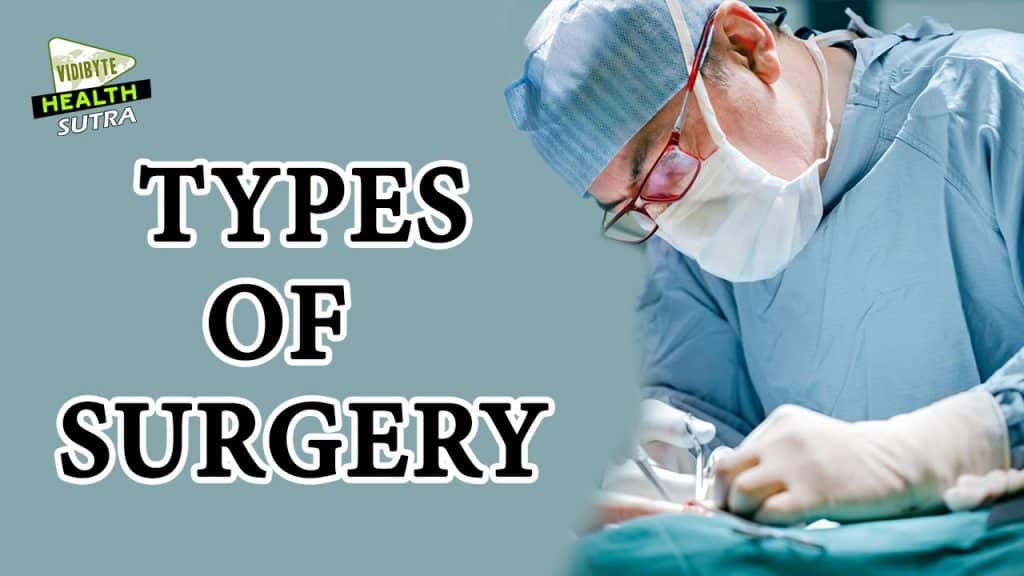Types of Surgery – Overview
Surgery is a procedure in which incision and physical manipulation are used to treat a patient with an injury or a disease. The patient’s tissues are cut during this technique to permit the manipulation of otherwise inaccessible tissues.
There are various types of surgery and they are classified based on several factors such as the timing of the surgery, the equipment used for the surgery and the purpose of the surgery.
The art of performing surgery may be referred to as “operation” or “surgical procedure”. Surgery is mainly carried out by a specialist doctor referred to as a “surgeon”.
He is assisted with other medical personnel such as anesthesia providers, circulating nurses, surgical technologists and surgeon’s assistants to form a surgical team.

types of surgery
Types of Surgery
There are various types of surgery and they can be classified based on different parameters.
Based on Timing
Surgery can be classified based on the urgency and need to perform the surgery.
1. Elective Surgery
The name “elective” might imply that this type of surgery is optional, but that’s not always the case. An elective procedure is simply one that is planned, rather than one that’s done in an emergency. A wide range of surgical procedures can be considered elective surgery. Cosmetic surgeries fall into this category, but so can things like ear tubes, tonsillectomies, and scoliosis surgery. Although these procedures may be done “electively,” they can be significant and potentially life-changing operations.
2. Semi-elective Surgery
Semi-elective surgery is a surgery that must be done to preserve the patient’s life but does not need to be performed immediately.
3. Urgent Surgery
Urgent surgery can wait until the patient is medically stable, but should generally be done today or tomorrow
4. Emergency Surgery
Emergency surgery must be performed without delay; the patient has no choice other than immediate surgery if they do not want to risk permanent disability or death.
Based on Body Part
Surgery can also be classified based on the body part that is being operated on.
When surgery is performed on one organ system or structure, it may be classed by the tissue, organ or organ system involved. Examples include:
1. Gastrointestinal surgery
This type of surgery is performed within the digestive tract and its accessory organs.
Gastrointestinal surgery involves the treatment for diseases of the parts of the body involved in indigestion. This includes the esophagus (ee-of-uh-guys), stomach, small intestine, large intestine, and rectum. It also includes the liver, gallbladder, and pancreas
2. Orthopedic surgery
This is performed on bones or muscles. The medical specialty is dedicated to the diagnosis, treatment, rehabilitation, and prevention of injuries of the musculoskeletal system including the muscles, bones, spine, joints, ligaments, tendons, and nerves.
3. Cardiovascular Surgery
Cardiovascular surgery is the surgical treatment of diseases and disorders of the heart and blood vessels. Examples of cardiovascular surgery include open-heart surgery such as coronary artery bypass grafting, heart valve replacements, heart transplant and vascular surgery such as abdominal aortic aneurysm repairs and femoral-tibial bypass grafting.
4. Gynaecology
Gynecology refers to the surgical specialty dealing with the health of the female reproductive system (uterus, vagina, and ovaries).
5. Neurosurgery
The surgical specialty is involved in the treatment of disorders of the brain, spinal cord, and peripheral nerves.
6. Ophthalmology (Eyes)
A medical specialty focusing on the diagnosis and treatment of disorders of the eye. Conditions include cataracts, glaucoma, and conjunctivitis, among others.
7. Oral and Maxillofacial Surgery
A dental specialty focusing on the diagnosis and surgical treatment of diseases, injuries and defects of the mouth, teeth and gums. Examples of oral surgery include removal of wisdom teeth, facial injury repair, cleft lip and palate repair, and repair of uneven jaws.
8. Otolaryngology – Ears, Nose and Throat (ENT)
Otolaryngology is the medical and surgical treatment of the head and neck, including ears, nose and throat.
9. Thoracic
This is also known as Cardiothoracic surgery. This is the field of medicine involved in the surgical treatment of organs inside the thorax (the chest)—generally the treatment of conditions of the heart (heart disease) and lungs (lung disease).
10. Urology
This is a type of surgery that is performed on the urinary tract. It is a surgical specialty that deals with problems affecting the urinary tract including kidneys, bladder, and prostate.
11. Plastic surgery
Plastic surgery is a surgery branch that focuses on enhancing a person’s appearance as well as reconstructing face and body tissue deformities produced by sickness, injuries, or congenital anomalies.
Plastic surgery optimizes and restores both function and aesthetics. Surgery on any portion of the body, except the nervous system, can be performed, including:
- Diseases and issues affecting the skin such as scars, burns, disfiguring cancer and birth-marks.
- Jaw and facial reconstructive surgery.
- Congenital malformations such as malformed ears, cleft lip and cleft palate.
12. Pediatric surgery
A specialized branch of surgery that treats abnormalities in babies, children, and adolescents that can be surgically repaired.
The goal of pediatric surgery is to repair congenital anomalies, diseases, trauma injury, or other abnormalities in a pediatric patient through surgery.
Based on Equipment Used
Surgery can also be classified based on the type of surgical equipment used for the procedure.
-
Robotic Surgery
Robotic surgery makes use of a surgical robot, such as the Da Vinci or the Zeus surgical systems, to control the instrumentation under the direction of the surgeon. Da Vinci’s advanced level of technology takes surgery beyond the limits of the human hand. This da Vinci Surgical System complements our goal of extending minimally invasive surgery to the broadest base of patients including but not limited to cholecystectomy (gallbladder removal), hysterectomies, myomectomies, Hiatal and hernia repairs, removal of one or both adrenal glands, GERD related diagnoses (Reflux), and esophageal stricture.
The da Vinci Surgical System offers
- Enhanced 3D, high-definition vision of the operative field, with up to 10x magnification
- New optimal dual console, which allows a second surgeon to provide assistance
- Ability to mimic the surgeon’s hand movements with enhanced dexterity
-
Microsurgery
Microsurgery involves the use of an operating microscope for the surgeon to see small structures.
The most obvious developments have been procedures developed to allow anastomosis of successively smaller blood vessels and nerves (typically 1 mm in diameter) which have allowed the transfer of tissue from one part of the body to another and re-attachment of severed parts. Microsurgical techniques are utilized by several specialties today, such as Replantation, Transplantation, treatment of infertility, etc
-
Laser Surgery
Laser surgery involves the use of a laser for cutting tissue instead of a scalpel or similar surgical instruments.
Laser surgery is commonly used on the eye. Techniques used include LASIK, which is used to correct near and far-sightedness in vision, and photorefractive keratectomy, a procedure that permanently reshapes the cornea using an excimer laser to remove a small amount of the human tissue.
Based on the degree of invasiveness
Surgery can also be classified based on the degree of invasiveness of the surgical procedure. By invasion, this refers to the medical procedure in which the part of the body is entered by incision.
-
Minimally Invasive Surgery
Minimally invasive surgery is any technique involved in surgery that does not require a large incision. This relatively new approach allows the patient to recuperate faster with less pain. Not all conditions are suitable for minimally invasive surgery. Many surgery techniques now fall under minimally invasive surgery: Laparoscopy, Endoscopy, Arthroscopy and many others.
-
Open Surgery
“open” surgery means the cutting of skin and tissues so that the surgeon has a full view of the structures or organs involved. Examples of open surgery are the removal of the organs, such as the gallbladder or kidneys.
Based on purpose
Surgery can also be classified based on the purpose for which the surgery is being performed. Surgeries are performed for various purposes and such can be classified based on the purpose of the surgery.
-
Exploratory surgery
Exploratory surgery is a diagnostic method used by doctors when trying to find a diagnosis for an ailment. It is used most commonly to diagnose or locate cancer in humans.
-
Therapeutic surgery
Therapeutic surgery treats a previously diagnosed condition
-
Cosmetic surgery
Cosmetic surgery is where a person chooses to have an operation or invasive medical procedure, to change their physical appearance for cosmetic rather than medical reasons.
In conclusion, there are different types of surgery and they are classified based on several parameters ranging from timing, body parts, equipment and purpose of the surgery.


